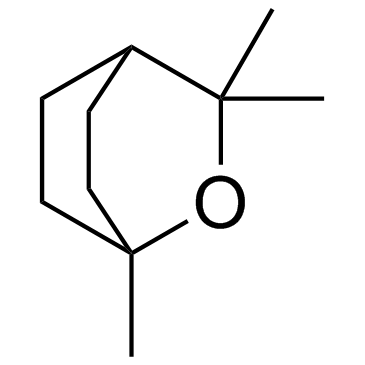Eucalyptol (1,8-Cineole) (Synonyms: NSC 6171) |
| Catalog No.GC30910 |
A bicyclic monoterpene with diverse biological activities
Products are for research use only. Not for human use. We do not sell to patients.

Cas No.: 470-82-6
Sample solution is provided at 25 µL, 10mM.
Eucalyptol is an inhibitor of 5-HT3 receptor ,potassium channel, TNF-α and IL-1β.
Eucalyptol inhibits 5-HT-evoked currents in oocytes expressing 5-HT3 receptors with an IC50 of 258 µM[1]. Eucalyptol (Cin) treatment significantly decreases the ROS level in Aβ25-35 treated cells in a dose dependent manner. Eucalyptol treatment significantly decreases the NO level in Aβ25-35 treated cells in a dose dependent manner (p<0.05 and p<0.01). Eucalyptol treatment also significantly decreases IL-1βlevel in Aβ25-35 treated cells in a dose dependent manner (p<0.05 and p<0.01) as compare to Aβ25-35 treated PC12 cells. IL-6 level is also attenuated by Eucalyptol in dose dependent manner (p<0.05 and p<0.01) as compare to Aβ25-35 treated cells[3].
Results show that male and female rats treated with Eucalyptol (CIN) at the highest doses, 500 and 1000 mg/kg, have shown lower body weight than control group from the 7th to 50th day of treatment. The administration of Eucalyptol significantly reduces body weight gain of male rats (Eucalyptol 500 and 1000 mg/kg) and female rats (Eucalyptol 1000 mg/kg) in the first week of treatment. However, this reduction is followed by an increase in body weight of rats males and females treated with all doses of the second week until the end of treatment. For male rats, there is a significant increase of 6.93% in mean corpuscular volume (MCV) (Eucalyptol 1000 mg/kg) and of 43.54 and 38.98% in the platelet count (Eucalyptol 500 and 1000 mg/kg, respectively) and a decrease of 6.74 and 6.67% in mean corpuscular hemoglobin concentration (MCHC) (Eucalyptol 500 and 1000 mg/kg) and mean platelet volume (MPV) of 10.40, 10.60 and 15.73% (Eucalyptol 100, 500 and 1000 mg/kg, respectively), when compare to the control group[4].
[1]. Jarvis GE, et al. Noncompetitive Inhibition of 5-HT3 Receptors by Citral, Linalool, and Eucalyptol Revealed by Nonlinear Mixed-Effects Modeling. J Pharmacol Exp Ther. 2016 Mar;356(3):549-62. [2]. Zeraatpisheh Z, et al. Eucalyptol induces hyperexcitability and epileptiform activity in snail neurons by inhibiting potassium channels. Eur J Pharmacol. 2015 Oct 5;764:70-8. [3]. Khan A, et al. 1,8-cineole (eucalyptol) mitigates inflammation in amyloid Beta toxicated PC12 cells: relevance to Alzheimer's disease. Neurochem Res. 2014 Feb;39(2):344-52.[3] [4]. Caldas GF, et al. Repeated-doses and reproductive toxicity studies of the monoterpene 1,8-cineole (eucalyptol) in Wistar rats. Food Chem Toxicol. 2016 Nov;97:297-306.
Average Rating: 5 (Based on Reviews and 11 reference(s) in Google Scholar.)
GLPBIO products are for RESEARCH USE ONLY. Please make sure your review or question is research based.
Required fields are marked with *




















